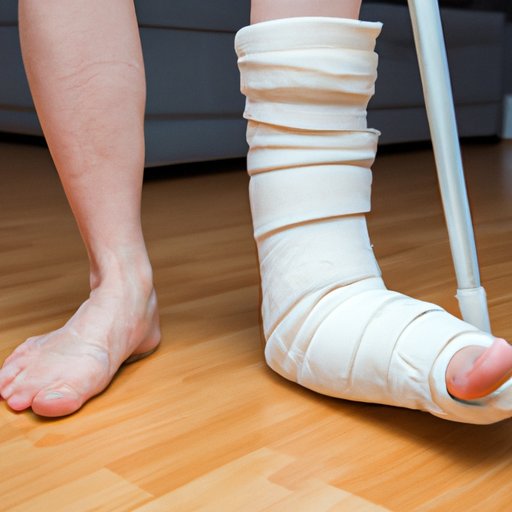
I. Introduction
Stress fractures are one of the most common injuries that occur in the foot. They are tiny cracks in the bone caused by repeated stress, often from overuse or physical activity. Walking with a stress fracture can be painful and can lead to further complications. In this article, we will explore whether one can walk with a stress fracture and best practices for managing the condition.
II. The Do’s and Don’ts of Walking with a Stress Fracture in Your Foot
If you have a stress fracture in your foot, it’s essential to take measures to reduce further damage. Here are some recommended ways to walk with a stress fracture:
- Use crutches or wear a walking boot to reduce weight on the injured foot
- Avoid walking long distances or engaging in high-impact activities
- Gradually increase physical activity as the fracture heals
On the other hand, there are certain activities and behaviors that can aggravate the condition. Here are some things to avoid:
- Avoid walking or standing for prolonged periods of time
- Do not participate in sports or activities that put pressure on the foot
- Avoid high-heeled shoes or shoes that do not provide adequate support and cushioning
III. How to Manage a Stress Fracture: Tips for Walking Comfortably
Walking with a stress fracture can be uncomfortable and, in some cases, painful. Here are some best practices for reducing discomfort and pain while walking:
- Ice the foot for 20 to 30 minutes at a time, several times a day
- Take over-the-counter pain medication, such as acetaminophen or ibuprofen, to reduce pain and inflammation
- Consider getting a massage or doing gentle stretches to help alleviate muscle tightness that may be exacerbating the pain
Choosing the right footwear is also crucial for those with stress fractures. Here are some recommended types of shoes for stress fracture recovery:
- Shoes with a low heel and good arch support
- Shoes with a cushioned sole to reduce impact on the foot
- Running shoes designed for those with injuries or foot conditions
IV. Walking or Not Walking with a Stress Fracture: What’s Best for Recovery?
The decision of whether to walk or not walk with a stress fracture can depend on various factors, such as the severity of the fracture, location, and individual circumstances. However, rest plays a crucial role in the healing process. Walking can put additional stress on the foot, which can worsen the condition. Therefore, it’s generally recommended to avoid walking with a stress fracture and to follow the guidelines set by a doctor or physical therapist. Resting the foot allows the bone to repair itself and can lead to a quicker recovery time.
V. The Risks of Continuing to Walk with a Stress Fracture
Continuing to walk with a stress fracture can lead to several complications that may require more intrusive medical treatment. Here are some potential risks of walking with a stress fracture:
- Delayed healing time
- Development of chronic pain or inflammation in the foot
- The potential for the fracture to become more severe
- The need for surgery or other invasive medical treatment
It’s essential to prioritize proper treatment and avoid the risks of continuing to walk on a stress fracture.
VI. Alternative Forms of Exercise for Those with a Foot Stress Fracture
Individuals with a foot stress fracture may feel limited in their ability to stay physically active. However, there are low-impact exercise options that can maintain cardiovascular health and strength without putting pressure on the foot. Here are some examples:
- Swimming or water aerobics
- Cycling or using a stationary bike
- Yoga or Pilates
- Upper body strength training exercises
Cross-training can also be an effective strategy for maintaining physical fitness while allowing the foot stress fracture to heal.
VII. When to Consult a Doctor about Walking with a Stress Fracture
It’s important to consult a medical professional for proper diagnosis and treatment of a foot stress fracture. Here are some signs and symptoms that indicate medical attention is necessary:
- Severe pain that does not subside, even with rest and pain medication
- The inability to put weight on the injured foot
- Swelling or redness around the foot area that persists
- Numbness or tingling in the foot
If you experience any of these symptoms, it’s best to seek medical attention as soon as possible.
VIII. The Mental and Emotional Impact of Having to Stop Walking Due to a Stress Fracture
Having to stop walking or reduce physical activity due to a stress fracture can have a significant emotional and mental impact on an individual. It’s common to feel frustrated, disappointed, or even depressed about the injury. Here are some coping strategies to manage the emotional and mental impact of the injury:
- Find alternative ways to stay active and engaged in physically and mentally stimulating activities
- Connect with friends and loved ones for support and encouragement
- Journal or practice mindfulness techniques to manage anxiety or stress
- Stay positive and focus on the recovery process
IX. Conclusion
Walking with a stress fracture can be challenging, uncomfortable, and potentially dangerous. Taking the necessary steps to manage the injury, following medical advice and guidelines, and prioritizing proper rest and recovery can lead to quicker healing times and reduce the risk of complications. Remember to prioritize your health and well-being, both physically and mentally.





